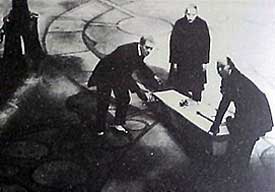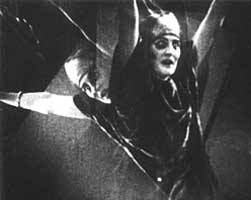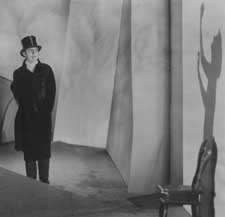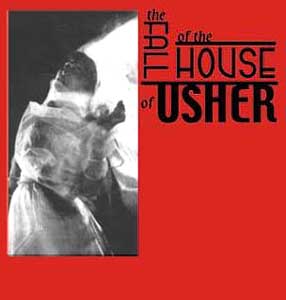Silent b/w The Fall of the House of Usher (La Chute de la Maison Usher, 1928), inspired by the 1839 tale by Edgar Allan Poe (with reference to additional works such as "Ligeia"), was adapted for the silent screen by the great Luis Bunuel, & directed by Jean Epstein. Visually this is a shadowy stunner.
 A gentleman, Allan (Charles Lamy), arrives at a roadside tavern afoot & asks if he can hire a man to drive him by coach to the House of Usher. The patrons are shocked even to hear the name of Usher. A gentleman, Allan (Charles Lamy), arrives at a roadside tavern afoot & asks if he can hire a man to drive him by coach to the House of Usher. The patrons are shocked even to hear the name of Usher.
Across the misty swamp sits the gloomy House. Roderick Usher (Jean Debucourt) & his crazed wife Madeleine (Marguerite Gance, wife of Abel Gance who has a small role in the tale) gaze wildly from vine-choked upper windows, down the lane as though forever expecting visitors who never arrive. But for once someone does come, Roderick's old friend Allan.
Neither Roderick nor his wife seem quite to be fully aware of the world around them, sunken as they are into decay & melancholy. Madeleine's regular physician (Fournez-Goffard) is baffled by her entranced condition.
Roderick obsessively paints his wife's portrait. Each brush stroke seems to sap her a little more of her existance. "It is here that she lives," Roderick confesses, showing Allen the portrait-in-progress.
When his mania for the portrait again overcomes him, he is eager to be rid of his visitor, who only came at his invitation but now seems a burdon. He sends his only friend onto the moors for a spooky walk then, with mad intensity, paints his wife, who writhes & fades with every dab at the convass.
After years of struggling with the portrait, it is at last completed. "This is indeed life itself!" Roderick triumphs when Allen returns from the moors. But at that same moment of completion, Madeleine fell dead to the floor.
Roderick is a student of occult magnetism & through his knowledge of arcane arts becomes convinced that Madelaine is not truly dead, that to bury her would increase the ferocity of this nightmare. He forbids the coffin be nailed shut, in case she awakens in her tomb.
The cavernous family tomb is an artistic wonder in itself. The artful photography & performances of catastrophic unhappiness do justice to Poe's famous mood-piece.
Madeleine's return & the finality of the supernatural affliction of the House of Usher is distinctly horrific yet somehow romantic.
Debucourt as Roderick has just the balance of beauty & creepiness that he is stunning in his role. His final descent into haunted madness is an astonishing mimed performance. Silent films at their most artful have a potential to be visual poetry, as this one is.
 I would not have thought it possible for another silent movie based on Poe's tale to be as interesting as one on which Luis Bunuel had such a hand. Yet James Sibley Watson & Melville Webber's short version of The Fall of the House of Usher, which was released the same year as the Bunuel & Epstein film, is a miniature wonder.
I would not have thought it possible for another silent movie based on Poe's tale to be as interesting as one on which Luis Bunuel had such a hand. Yet James Sibley Watson & Melville Webber's short version of The Fall of the House of Usher, which was released the same year as the Bunuel & Epstein film, is a miniature wonder.
At under a quarter hour, this is all moodiness & shadow as a lone rider (Melville Webber) approches the the House of Usher. Some highly unusual FX are inserted, advanced for this early period, & appealing even now.
Roderick & Madelaine Usher (Herbert Stern & Hildegarde Watson) are at their dining table, for the moment seemingly a normal couple, until Madelaine goes into nervous collapse amidst ghostly apparitions which Roderick possibly doesn't see.
 Without text cards, it's completely a visual experience. If the story weren't so familiar through Poe it would lead to very curious interpretations, but knowing the story perfectly well, it's easily followed despite the changes & the radically expressionist presentation. Without text cards, it's completely a visual experience. If the story weren't so familiar through Poe it would lead to very curious interpretations, but knowing the story perfectly well, it's easily followed despite the changes & the radically expressionist presentation.
Madelaine lives in a phantasmagoric world beyond others' comprehension. It's not clear that Roderick is anything but the protector of a madwoman, though he may well share some responsibility for her condition.
The abject beauty of this film exceeds in visual power Carl Dryer's Vampyr (1932) which duplicates some of the tricks of wall-shadows. Staircases move like escalators, walls tilt, doorways are impossibly out of kilter, while covered plates from the kitchen fly about like alien space craft, a surprise that flying saucer lore was already in place by 1928.
In the chaos-driven climax, an alphabet from occult books drift through the rooms of the House of Usher & Madeleine rises from her coffin. We are left to wonder if she even exists, or has it been, all along, Roderick who lives in a world of hallucination.
This brilliant nightmare is more extreme in its design than The Cabinet of Dr. Caligari (1920), the preeminant German Expressionist fantasy, & to which Usher pays extreme homage.
The version I saw had an effective musical soundtrack by Impossible Orchestra, a rare case of an unobtrusive & effective add-on.
copyright © by Paghat the Ratgirl
|

 A gentleman, Allan (Charles Lamy), arrives at a roadside tavern afoot & asks if he can hire a man to drive him by coach to the House of Usher. The patrons are shocked even to hear the name of Usher.
A gentleman, Allan (Charles Lamy), arrives at a roadside tavern afoot & asks if he can hire a man to drive him by coach to the House of Usher. The patrons are shocked even to hear the name of Usher.
 Without text cards, it's completely a visual experience. If the story weren't so familiar through Poe it would lead to very curious interpretations, but knowing the story perfectly well, it's easily followed despite the changes & the radically expressionist presentation.
Without text cards, it's completely a visual experience. If the story weren't so familiar through Poe it would lead to very curious interpretations, but knowing the story perfectly well, it's easily followed despite the changes & the radically expressionist presentation.